Posts Tagged ‘Mark Millar’
 Hi ho, happy readers it’s Jonny here!
Hi ho, happy readers it’s Jonny here!
Who even writes for this blog anymore? Certainly not us! Anyway, I just read a magnificent issue of Swamp Thing from the year 1996!
Clinton was in office and Dole wanted to oust him. Newt Gingrich had signed some weird “Contract with America” and the world of American politics was as nutty as ever. Apparently disgusted with himself, the comics industry, and left-wing socialist nut-jobs Mark Millar enlisted the incredible talents of Curt Swan to create this fascinating bit of satire.
If you’re familiar with Alan Moore or Rick Veitch’s work on Saga of the Swamp Thing then you know Chester Williams as an eco-friendly former hippie that loves tubers and teams up with the Swamp Thing to battle evil.
But that was before he saw the Contract!
Professor Chester Williams is at his apartment throwing a party with another professor and some of their students. The kids are dancing, drinking, getting high, and engaging in other immoral activities. After a living the hippie dream this party serves as a wake up call to Mr. Williams and he’s had enough! Chastising a young lady for strip-dancing at the party Chester proceeds to kill the music and call the cops on his students.
Disgusted with the loose living of these young liberals, Chester decides to join the NYPD and clean up America. After killing a few bank robbers (illegal immigrants no less!), saving a woman from being robbed [Ed. note: a “dyke,” who he then kisses so hard she goes straight and marries him], and plenty of good old fashioned liberal bashing, Chester receives word that the Swamp Thing is giving the world’s leaders an ultimatum: stop polluting or else! As an old friend of this Elemental, Officer Williams decides to pay a visit to Houma, LA to try and talk some sense into the old Swamp Hippie.
After a stern lesson on economics, the importance of international trade, and a plea for Swamp Thing to “grow up”, Chester convinces Swamp Thing that the earth doesn’t need a paradise and things are best left as they are. Chester then returns to New York where he defeats incumbent Bill Clinton and becomes President of the United States of America!
Conservative ideals win again!
Happy readings!
– Jonny
[Ed. note: Despite Mark Millar’s bizarre introduction to the issue claiming it is the first “clean issue in a sick run of an evil book put together by diseased individuals,” editor Stuart Moore later promises it was “an Elseworlds story” and “a bad trip or something.” Thank God.]
When Will Eisner Met Wolverine
Posted on: September 5, 2009
When it comes to Marvel books, I am crazy picky. I mean, it’s not like Marvel is bad or anything; hell, the first comics I ever bought with my own money were beat-up copies of the first four issues of both Excalibur and West Coast Avengers. It’s more like I grew out of the action-driven books of Marvel in the nineties and grew into the character-driven books of modern DC. Occasionally, however, I’ll stumble across a Marvel story that I absolutely adore. I found the two volumes of Wolverine: Enemy of the State by Mark Millar and John Romita, Jr. in a 50% off bin and it quickly became one of my all time favorite story arcs from ANY publishing house.
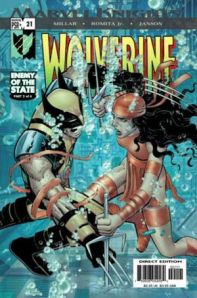 The basic premise of Enemy of the State is kinda complicated. Wolverine goes back to Japan (for the first time since he had to kill his old flame, Mariko) to play the Denzel Washington role and help an old buddy get his kid back. Turns out that it was all a trap set by the Hand, the Dawn of the White Light (led by some fucker named the Gorgon, but not the one from the Inhumans) and HYDRA to get him to where they were, kill him, resurrect him, and turn him into their own personal zombie contract killer. Wolverine ends up squaring off against Elektra, Nick Fury (and the rest of S.H.I.E.L.D.), the Fantastic Four, Daredevil, and the X-Men, even going so far as (big ol’ fuckin’ spoiler, everybody) killing Northstar (but it’s Marvel, so nobody [Jean Grey excluded] stays dead longer than, like, a volume at the most).
The basic premise of Enemy of the State is kinda complicated. Wolverine goes back to Japan (for the first time since he had to kill his old flame, Mariko) to play the Denzel Washington role and help an old buddy get his kid back. Turns out that it was all a trap set by the Hand, the Dawn of the White Light (led by some fucker named the Gorgon, but not the one from the Inhumans) and HYDRA to get him to where they were, kill him, resurrect him, and turn him into their own personal zombie contract killer. Wolverine ends up squaring off against Elektra, Nick Fury (and the rest of S.H.I.E.L.D.), the Fantastic Four, Daredevil, and the X-Men, even going so far as (big ol’ fuckin’ spoiler, everybody) killing Northstar (but it’s Marvel, so nobody [Jean Grey excluded] stays dead longer than, like, a volume at the most).
But the best thing about this run didn’t happen until the last issue. The Wolverine vs. the Marvel universe plot only lasted 11 issues and Millar had one left over. So what does he do? Inadvertent collaboration with Will Eisner, engage!
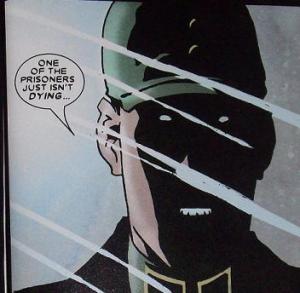 Featuring Wolverine in a Nazi concentration camp during World War II, Wolverine #32 was beautiful and strangely depressing. According to an essay by Mark Millar, he wanted to tell this story SO BADLY, but couldn’t figure out how. Wolverine’s familiar voice seemed out of place in a story like this (calling anybody at Auschwitz “bub” might be a smidge insensitive) and Millar didn’t know what to do. Then, while he was a banquet, in comes some old dude to sit next to him. They strike up a conversation about Millar’s problem. The man’s solution to Wolverine’s churlish lingo?
Featuring Wolverine in a Nazi concentration camp during World War II, Wolverine #32 was beautiful and strangely depressing. According to an essay by Mark Millar, he wanted to tell this story SO BADLY, but couldn’t figure out how. Wolverine’s familiar voice seemed out of place in a story like this (calling anybody at Auschwitz “bub” might be a smidge insensitive) and Millar didn’t know what to do. Then, while he was a banquet, in comes some old dude to sit next to him. They strike up a conversation about Millar’s problem. The man’s solution to Wolverine’s churlish lingo?
“Then don’t make him talk.”
Turns out, the clever old man was Will Eisner. If you want the whole story, it’s in the trade. Go get it.
Anyways, the silence worked beautifully. Wolverine keeps using his quick-healing ability to torment the head of the camp, who is bent on killing him. Every time they attempt to execute Logan he comes back and just grins at them, never saying a word. Eventually, Head Nazi ends up accidentally killing himself while trying to personally execute Wolverine in a fit of rage. And Wolverine just keeps grinning. Every time he pops back up is one of those important comic book “oh shit” moments that we all love. Shot in the face? Doesn’t matter. Set ablaze? Whatevs. He’s back and he’s smiling and he’s silent and he’s creepy as fuck (to both the Nazis and, for some reason, me). Extremely haunting, highly recommended, read this issue with a glass of Fancy Scotch on the rocks.
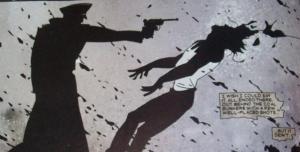
Of course, the issue is dedicated to Will Eisner. As far as I know, with its release in 2005, the last issue of Wolverine: Enemy of the State was Will Eisner’s final actual creative contribution to a comic book. It was a hell of an issue and a hell of a way for Mr. Eisner to add a flourish to his final bows. Even though this technically is NOT an Eisner book, this is the story that makes me want to go back and read Eisner’s body of work I added Fagin the Jew and A Contract With God to the top of my tattered “to buy” list, and I can’t wait to track them down and read them.
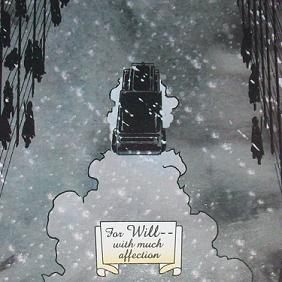











 Kick-Ass, the comic, despises its protagonist. Kick-Ass, the comic, thinks Dave Lizewski is a creepy (possibly sick in the head) loser, and while he’s certainly relate-able, Dave Lizewski is kind of a creepy loser. Kick-Ass, the movie, on the other hand, takes pity on this poor sad sack of teenage angst and allows his wish fulfillment fantasies to go ahead and work out, a notion the comic has utterly rejected, at least so far.
Kick-Ass, the comic, despises its protagonist. Kick-Ass, the comic, thinks Dave Lizewski is a creepy (possibly sick in the head) loser, and while he’s certainly relate-able, Dave Lizewski is kind of a creepy loser. Kick-Ass, the movie, on the other hand, takes pity on this poor sad sack of teenage angst and allows his wish fulfillment fantasies to go ahead and work out, a notion the comic has utterly rejected, at least so far.




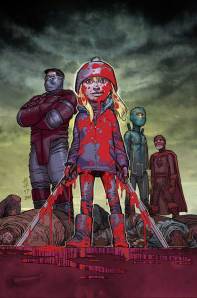










Comic Book Self Awareness Part 1: The Unfunnies
Posted by: jdcrymes on: March 24, 2010
WARNING: SPOILER ALERT
I will be breaking one of my personal rules by revealing specific plot points under the assumption that most of you have either read this book already (it debuted in 2004) or will never read it anyway. The Unfunnies can be ordered from Avatar Press, and if you’re in to this sort of thing I recommend buying your own copy and coming back to my review later. For the rest of you, here we go.
The Unfunnies is set in a Hannah-Barbera-esque cartoon world of anthropomorphic animals with cutesy names like “Sally Gator” and “Birdseed Betty”. From the first panel Mark Millar is forcing us to acknowledge that comics are simplified, surreal, and most importantly: a world already familiar to readers. This idealism is extremely short-lived, but is perhaps the most integral part of the analysis. When we read comics, we already know basically what we’re getting in to. Whether found in newspapers, monthly subscriptions, or even the “indie” trades that make us feel cool, we expect to see thick, black lines and bold colors depicting a world of good and evil, and we know the good (or better) side is going to win in the end. This is, of course, only natural. Humans love novelty, but we love predictability even more. Nobody wants to take a sip of coffee to find out it was replaced with urine. That would be terrible. Human beings build rigid patterns for perceiving the world and dislike when those sensibilities are challenged. This may not be profound, but it is important to this piece.
Yes. They are doing what it looks like they're doing.
As I said, the world of The Unfunnies is familiar, but this only lasts a few panels. A cute family of crows is unsettled when the police enter to arrest husband/father Moe the Crow on charges of child pornography. Expectations: shattered. This act of immorality (chosen as one universally despised for maximum effect) sets the tone that will embody the rest of The Unfunnies . Acts of increasing depravity continue. Birdseed Betty (former loving wife of Moe the Crow) is forced to prostitute herself to the landlord to avoid eviction for herself and her young flock. A chicken youth named Chick-Chick Chickie is wandering about the town offending adults with the most unsavory language the horrified listeners have ever heard, and Dr. Despicable is convincing patients to undergo life-changing procedures they do not need to satisfy his growing sadism. All the while local policeman Sheriff Dribble is attempting to understand how his once pleasant world of capers and comedic misunderstandings has become so hellish. Millar is contrasting the world comics once were with the world they are quickly becoming.
Somewhere in the first issue of The Unfunnies the reader is shown a rather confusing image. Local mailman Frosty Pete (a penguin) is trading pornographic images via email when we are shown a real-life picture of a human. This is not a drawn image. Rather it is a real picture of a real person. The contrast between the comic and the reality is so abrasive it offends the reader’s eyes. Though confusing, this image is key. I will not ruin any more of the misery by recalling every character’s horrid tale except to say: there are more characters, and their lives are completely ruined in horrid ways.
As the tragedy unfolds the heroic Sheriff Dribble gets closer and closer to uncovering what powers are at work, and the name “Troy Hicks” becomes more frequent. Readers are lulled into expecting a happy ending when our pitiful protagonists begin to see their lives turn around. A silver lining emerges! This is, of course, smashed as it is finally discovered that the world of the Unfunnies is the creative project of one Troy Hicks. After being handed a death sentence in the real world (our world) for raping and murdering 8 children, Hicks hatched a plan to swap places with one his own comic characters, thereby living forever in a comic. Frosty Pete was the unfortunate soul who took the bait of pornographic images sent in an email, and now finds himself on Death Row in our world for Hicks’ crimes. Troy Hicks, now transplanted into his own comic world, is free to wreak any havoc or obscenity he sees fit. The comic ends as Hicks, possessing the body of Frosty Pete, walks down the road with Sally Gator’s newborn baby – presumably to have his way with it.
Here is revealed the ultimate point of Millar’s story. By inserting their own depraved concepts into their work, modern authors have contaminated the once innocent world of comics. Take that Garth Ennis.
I do not know if Millar was trying to make this commentary, or if it was just an interesting by-product of the most disturbing comic I’ve personally read. Given the intentional nature of every aspect depicted I’m inclined to think it was on purpose. If not, I wonder how Millar can sleep with such grotesqueries floating in his head. Now I would like to take a moment to point out that I do not actually recommend this book. Though well written, expertly drawn, and highly provocative The Unfunnies was just too disturbing and gross for my tastes. In High Five! Comics tradition I will end this post with the drink I pair with The Unfunnies. Bourbon. Or whiskey. Just get smashed with something strong.
-Jonny